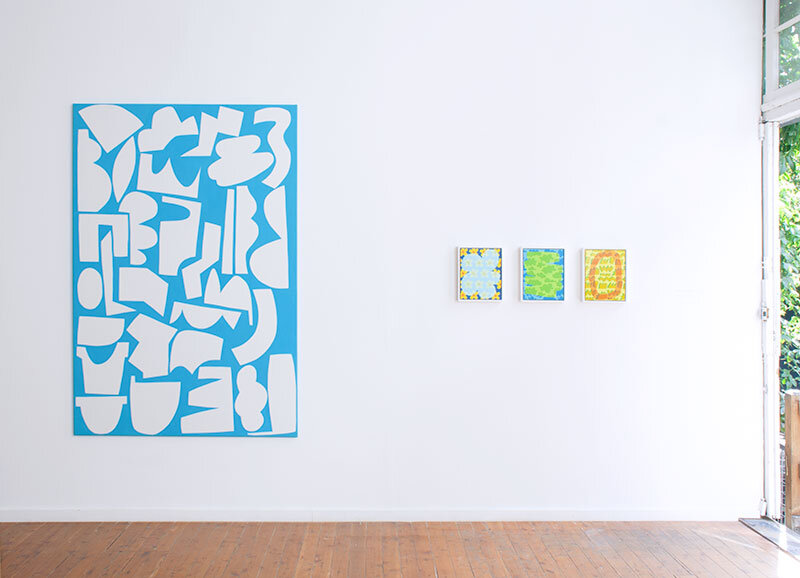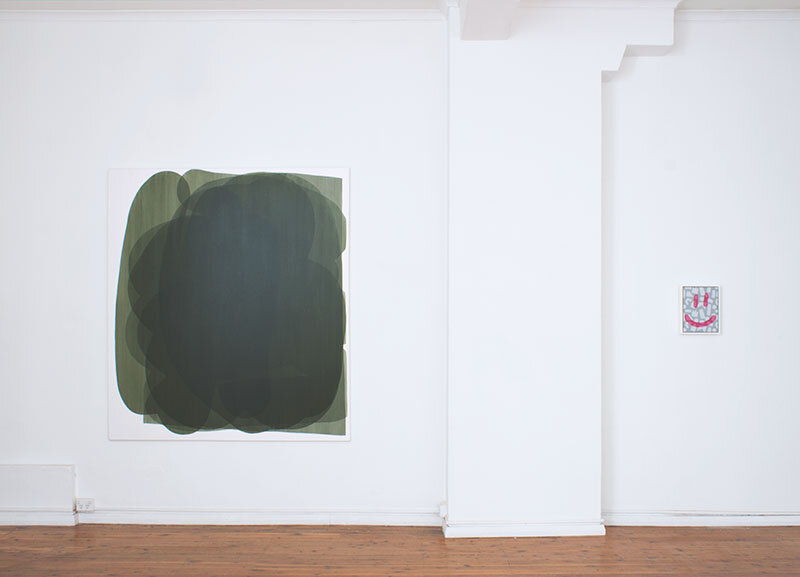Exhibition
Decorate, 2017
Wellington Street Projects, Sydney
4 - 28 July 2018
Decoration as Discourse: The language of pattern in the paintings of Simon Degroot.
Jess Berry
‘Any decoration is futile, when it does not remind you of something beyond itself.’
William Morris 1
When the architect Adolf Loos wrote ‘Ornament and Crime’ in 1908, he set about a discourse of disavowing decoration that became the cornerstone of Modernist design.2 Decoration was a dirty word, and the pleasurable surfaces of domestic space were replaced with blank and empty white cubes. Simon Degroot brings these two seemingly antithetical discourses together again in his exhibition, Decorate; where the sparse armature of the grid comes into contact with exuberant patterns derived from everyday life. In this way the artist converses with a complex terrain of art, design and craft hierarchies, a risk that might easily cast his work in the disdained realm of the frivolous or inconsequential. The works overcome this problem by cleverly filtering a diverse lexicon of sources: pop art, postmodern design, and kitsch, along with geometry, abstraction and formalism—so drawing attention to the debates of decoration that have often shaped art history.
Disparaging comparisons between painting and wallpaper were almost an overly exploited equation in the 1950s. Harold Rosenberg described gestural abstraction as ‘apocalyptic wallpaper’ and Clement Greenberg differentiated flat-surface abstraction from ‘collapsing into decoration, mere wallpaper patterns.3 To evoke wallpaper in painting then, is to suggest an anxiety around possible slippages between abstraction and decoration that might lead to painting’s fall from the graces of high-art. Painting’s claim to aesthetic and conceptual superiority and authority is called into question if equated to the emptiness of the merely ornamental. Degroot wilfully engages with these slippages, by recontextualising wallpaper patterns as abstract images he identifies the tensions and similarities between these two formal languages. The machismo and heroics associated with modernist abstraction are playfully contorted through personable DayGlo colours, rainbows and fleurons. This task reminds us of why pop-art tried to transgress the boundaries of fine art by suggesting that painting could be another form of decoration in the realm of popular culture. Warhol’s wallpapers for instance, relished their associations with the decorative, the domestic and the feminine by critiquing the heterosexual bravado of abstract painting.
In this way, Decorate can be understood as an extension of concerns explored in 1970s American painting. In particular, the Pattern and Decoration Movement (P&D) sought to restore the domestic and the decorative in art, critiquing the austerity of minimalism and re-dressing modernism’s omissions. Artists such as Robert Zakanitch and Joyce Kozloff produced large, boldly coloured paintings derived from wallpaper, tablecloths and rugs as a method for examining how modernism obscured feminine and non-western art forms. This short-lived, and now often forgotten movement, was a symptom of the need for art historical reform through the lens of feminism. While it might now be seen as visually chintzy, it recognised the decorative function in art as a way overcoming the limitations of abstraction.4 Where it likely failed was its overindulgence in the overloaded, and sentimental approach to its florid sources.
Degroot has observed these lessons well, this is an exhibition of exclusions, simplifications and expanded space closer to a Matisse collage than a patchwork quilt. The artist’s methods: decontextualisation, layering, and superimposition establishes spatial complexity, both within the bounded frame of the canvas and through the inter-relationships of the paintings with each other. These methods are indebted to discourses of postmodernism, that punctuate each of the paintings in the exhibition. A notable example of this can be seen in Memphis Circle (2017). Here the artist draws on forms derived from Ettore Sottsass’ design studio Memphis, and the influence of radical Italian architecture such as Superstudio and Archizoom. Memphis design invited the viewer into an aesthetic world of pattern and decoration that evoked child-like wonder while engaging with stylistically historical motifs. Degroot’s patterns are similarly bright, humorous and ironic and like these earlier design icons, uses the arbitrary decorative elements of kitsch to stimulate the senses and rouse imagination. In this way Degroot’s decoration conveys something beyond ornamentation. These are not futile paintings but juxtapositions of images that are evocative and joyful in their nostalgic appropriation of 1980s colours and reference points.
While Degroot’s paintings make clear reference to the past, and a range of art historical discourses, they also consist of forms that are familiar to us in contemporary daily- life. The artist adopts the imagery of emoticons and glyphs speaking to the idea of dispersion. That is, how an image or symbol can start off in one context and find its way into the minds of millions through the translation of digital culture. They are a decorative equivalent to a meme, riffing off our cultural reference points, multiplying and translating into new contexts, where the vernacular and everyday become worth sharing. In this way Degroot’s dynamic paintings reminds us that ‘Decorative art is the oldest new art there is.’5
1. William Morris, cited in Charlene Spretnak, The Resurgence of the Real, New York: Routledge, 1999, 200.
2. Adolf Loos, ‘Ornament and Crime [1908].’ Ornament and Crime: Selected Essays. Trans. Michael Mitchell. California: Riverside, 1998, 167-76.
3. Rosenberg and Greenberg cited in Elissa Auther, ‘Wallpaper, the Decorative and Installation Art,’ Extra/Ordinary: Craft and Contemporary Art, ed. Maria Elena Buszek. Duke University Press, 2011, 119
4. Anne Swartz (ed.), Pattern and Decoration: An Ideal Vision in American Art, 1975-1985. New York: Hudson Museum, 2007.
5. John Perreault, ‘Issues in Pattern Painting’, Artforum, 15:3 (November, 1977): 32-36.

